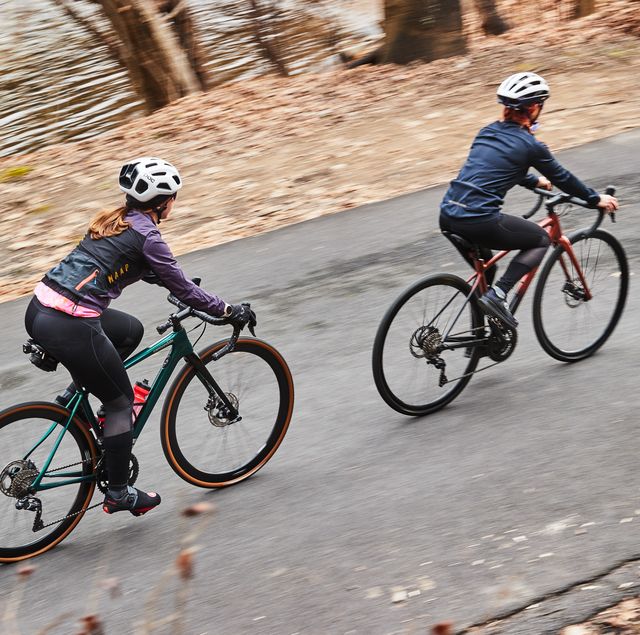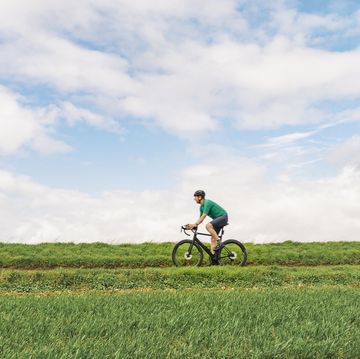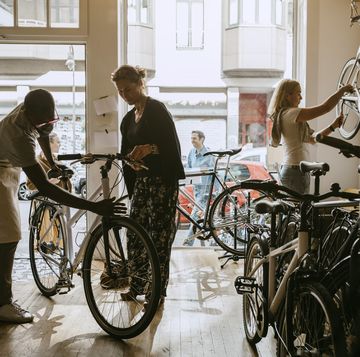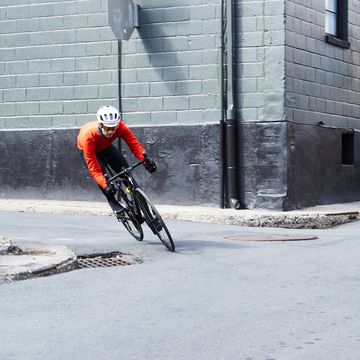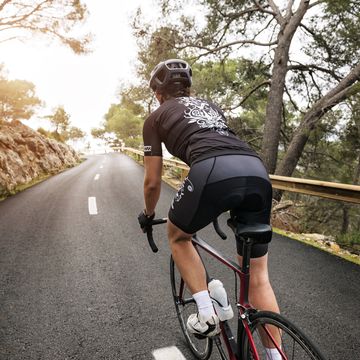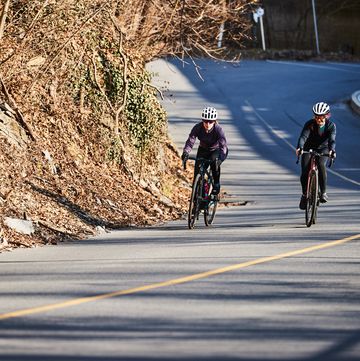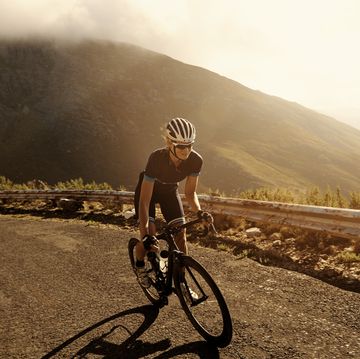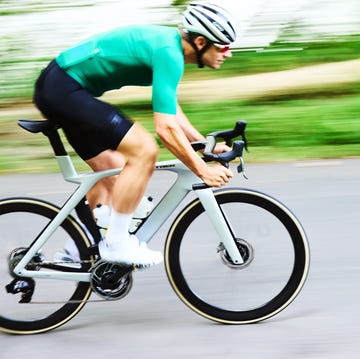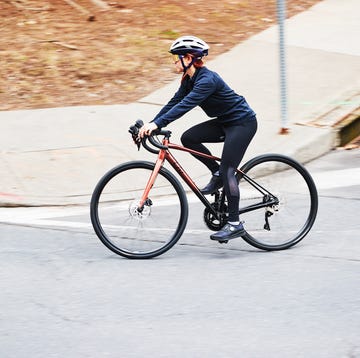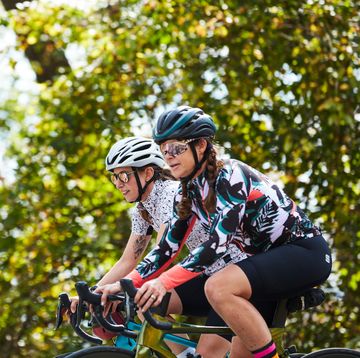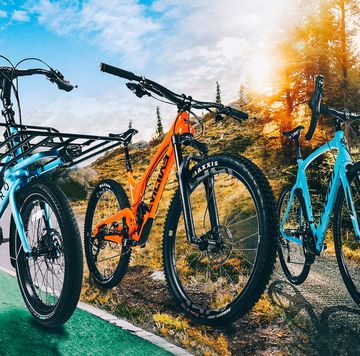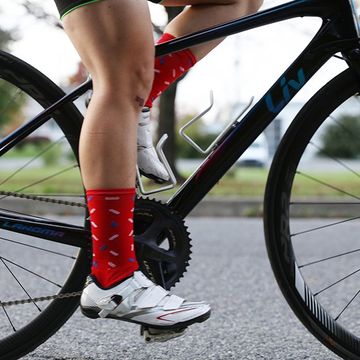To get started in cycling, you don’t need special clothes or shoes, or even an expensive, new bike (although it sure is fun to have one!). All you need to become a cyclist is a bike that fits you, a helmet, and some understanding of the rules of the road.
To help build your confidence on two wheels, we gathered the best beginner road biking tips so you can begin pedaling today.
The Best Beginner Road Biking Advice
1. Choose the Right Bike
Of course, you can’t get started without a great set of wheels. While we’re big fans of all types of bikes, we’re specifically talking about bikes suitable for the road. This is the most common and accessible form of cycling for beginners, and the bikes are designed to help you navigate paved bike paths and city streets.
Just like picking the perfect pair of running shoes, you first need to size your bike. Stand over the top tube and shoot for about an inch of clearance between your body and the frame. Or, when sitting on the saddle, aim for just a slight bend in the knee at the bottom of your pedal stroke. We highly recommend visiting your local bike shop, though, as you can try different styles and sizes.
Over the last few years, road bikes have gone electric, so check out the latest fleet of e-bikes if you want to rely on power coming from more than your own body.
Of course, you also want to pick a bike that fits your budget and riding style. Are you going to log casual miles on the weekends? Are you planning to commute to work? Road bike frames have specific styles and components tailored for each of these goals, and there are some at every price point.
So, think about how you intend to use the bike now, and how you might want to grow with it. For example: Maybe you can only ride 20 miles now, but you have a 100-mile ride in your sights. That is information to tell the specialist when you visit your local bike shop so they can help you make the best purchase.
2. Pick a Helmet
You should always wear a helmet when you ride, but don’t just grab the one that’s been sitting in your garage. Helmets have a shelf life and new helmets have to meet U.S. safety standards. Try on a few and pick one that’s comfortable and that you like. If you love it, you’ll wear it.
3. Stay Safe
Wearing a helmet is important, but there’s more to staying safe on your bike than just protecting your head.
When riding alone, always carry a basic multitool, a form of identification, cash (dollar bills can also be used as a tire boot), and your phone in case of an emergency. As much as we hate to admit it, not all rides go as planned and you don’t want to find yourself stranded on the side of the road with no way to get help.
Follow local traffic laws, which includes coming to a complete stop at red lights and stop signs (even on group rides), and using appropriate hand signals when making a lane change or turn.
Most importantly, never assume the driver of the cars around you know how to drive near a road cyclist. The more aware you are of your surroundings, the more you can anticipate any drivers not paying attention or hazards out on the road.
By the way, never wear headphones or earbuds while riding outdoors. If you need tunes for motivation during a ride, opt instead for a small Bluetooth speaker and store it in your pocket or water bottle cage.
4. Create a Habit
Your first few rides might be tough—your body is adjusting to the stress of a totally new activity. But like all things in life, real progress is made when you stick with it for the long run.
The first step in making your beginning road biking habit stick is to set some realistic goals. Don’t expect to magically become a morning person just because you have a new bike, or plan to ride 100 miles too soon. Start small and grow from there.
No matter when you choose to ride, lay out your gear, fill your bottles, and pump up your tires ahead of time. Prepping and deciding to get on the bike is sometimes the hardest part of cycling, so do a little preride preparation will prevent excuses from getting in the way.
Setting a long-term goal is also a great way to stay engaged and track progress. You can aim to ride a certain number of days a week or look for a local charity ride, gran fondo, or create your own long-term mileage goal.
5. Try a Group Ride
You’ll quickly find that cycling is a social and supportive sport. Many bike shops host no-drop (meaning they won’t leave you behind) group rides, designed to teach beginner road cyclists group etiquette and showcase local routes. Another great reason to visit a local shop!
Weekly group rides can hold you accountable and give you the extra push you need to throw your leg over the saddle when motivation is lacking. Many people in these organized rides have advice from years of experience that they’re more than willing to share—watch, learn, and ask questions.
You can certainly ride and accomplish goals alone, but riding with a group can make cycling easier both physically (you can draft off each other for less wind resistance) and psychologically (your new friends will motivate you).
6. Identify Your Ride Style
As you spend time in the saddle, you’ll learn more about your personal riding style and preferences. Maybe you’ll love riding solo or decide to ride non-competitively with a group. Maybe you yearn to race or you just want to ride to work every day. There are endless ways to ride and enjoy riding—it just takes a little trial and error to find your road ride style.
Eventually, you may also find that your body type and talents lend themselves to a specific type of riding. If you find yourself breezing uphill faster than your friends, climbing may be your cup of tea. If you can pull away during a group ride, sprinting is likely your forte. Being a well-rounded cyclist is always the goal, but fostering your strengths (or what you enjoy most) is a surefire way to keep cycling fun. Plus, it’s part of the sport—professional cyclists generally specialize in one style, whether it’s sprinting, climbing, or time trialing.
7. Get Other Gear
Not quite ready to look like a Tour de France rider yet? No problem. There are plenty of brands that make cool cycling apparel for recreational riders, like the Bike Style collection from Pearl Izumi.
If you do aspire to look like a pro, we’ve got you covered there, too. A cycling kit (a jersey, matching padded bib shorts or bike shorts, and socks) is more aerodynamic and comfortable on the bike than other athletic clothes. The material wicks away sweat and helps regulate body temperature, the form-fitting cut reduces chafing, and the padded seat (chamois) protects sensitive areas from road vibration. Jerseys are available in race- or relaxed-fit and endless colors and patterns.
While we suggest starting your cycling journey with standard flat pedals and athletic shoes, eventually you may want to transition to road bike shoes and clipless pedals. This shoe-pedal combination secures your feet in place to improve pedaling efficiency and bike handling. Unclipping can sometimes be tricky, so be sure to practice in a field until you get the hang of it.
Other important items include bike tools (tire levers, a mini pump, spare tubes, and a multitool) and a cycling computer, which comes in handy for tracking mileage and navigating routes.
To stay hydrated as you ride, you should also have a water bottle and a water bottle cage too.
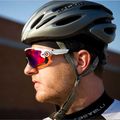
Michael Nystrom is a two-time IRONMAN finisher and a former editor at Active Network, Muscle & Performance and Oxygen Magazine. He covers all things cycling, from the Tour de France to new product releases, and has been published by USA Triathlon, Under Armour, Polar, Triathlete Magazine and more. When not swimming, cycling or running, he’s catching some waves or chasing his dog, Dingo.
